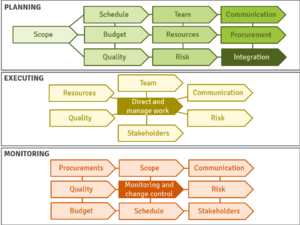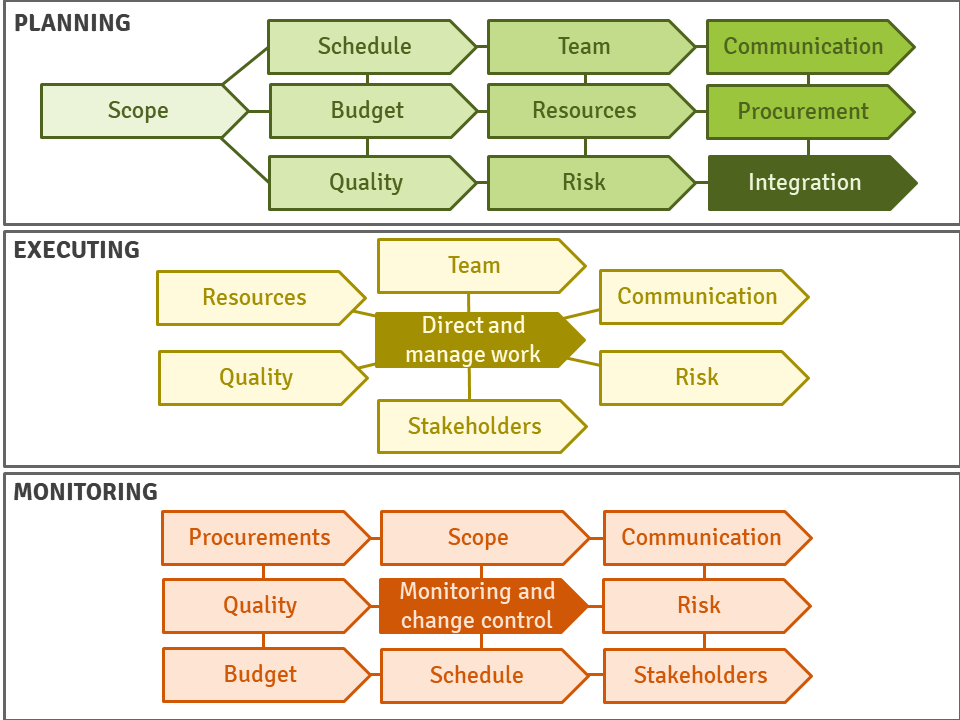Approach to project management
The system approach to is a method of organizing and managing project activities in a systematic and organized manner. It involves breaking down a project into smaller, more manageable components, and then using a set of standardized processes and tools to plan, execute, and control the project. The system approach typically includes the use of project management software, clear project objectives, a detailed project plan, and a system for monitoring and controlling project progress. This approach is designed to improve project efficiency and effectiveness by reducing the risk of project failure and ensuring that all stakeholders are aligned and working towards the same goals.
The system approach principle, is one of several principles used in project management practice. Its recommendations and guidelines underlay the structure of research methodologies, specific methods and techniques, which are used in the design process.
Contents
- 1 Features of system approach to project management
- 2 Example of system approach to project management
- 3 Benefits of system approach to project management
- 4 Limitations of system approach to project management
- 5 What system approach is?
- 6 References
Features of system approach to project management
The system approach to project management has several key features, including:
- Breakdown of project into smaller components: The system approach involves breaking down a project into smaller, more manageable components, which makes it easier to plan, execute, and control the project.
- Standardized processes and tools: The system approach uses a set of standardized processes and tools, such as flow diagrams, Gantt charts, and PERT diagrams, to plan, execute, and control the project. These tools help to streamline project management activities and reduce unnecessary steps or delays.
- Detailed project plan: The system approach includes a detailed project plan that outlines the schedule for each phase of the project, the resources required, and the budget. This plan is used to guide the project from start to finish and ensure that it is completed on time and within budget.
- System for monitoring and controlling progress: The system approach includes a system for monitoring and controlling the project progress, which helps to identify and address any issues or problems that arise during the project. This helps to keep the project on track and ensure that it is completed as planned.
- Clear roles and responsibilities: The system approach clearly defines the roles and responsibilities of all stakeholders, which helps to improve communication and coordination among project team members.
- Continual improvement: The system approach encourages continuous improvement, by regularly reviewing and updating the project plan and processes to identify areas for improvement and optimize performance.
- Risk management: The system approach includes a risk management plan to identify and mitigate potential risks and issues that may arise during the project.
- Quality management: The system approach includes a Quality management plan to ensure that the project deliverables meet the quality standards and requirements.
- Alignment with organizational goals: The system approach aligns the project goals and objectives with the organizational goals and objectives.
- Integration: The system approach integrates all aspects of the project and all stakeholders to ensure a cohesive and successful project outcome.
Example of system approach to project management

Fig.1. System approach to project management.
In projects we often use system approach and we event don't realize this. An example of the system approach to project management is the construction of a new skyscraper. The project would be broken down into smaller, more manageable components, such as site preparation, foundation work, steel construction, electrical and plumbing systems, and finishing work. A project manager would use a set of standardized processes and tools, such as flow diagrams, Gantt charts, and PERT diagrams, to plan, execute, and control the project.
The project manager would start by defining the system boundaries and objectives for the project, such as the size and scope of the building, the budget, and the deadline for completion. Next, the project manager would identify the components of the system and how they are interconnected. For example, site preparation would need to be completed before foundation work could begin, and steel construction would need to be completed before the electrical and plumbing systems could be installed.
The project manager would then develop a detailed plan for the system, including a Gantt chart that outlines the schedule for each phase of the project and a PERT diagram that illustrates the dependencies between different components of the system. Once the plan is in place, the project manager would implement the plan and monitor the progress of the project using tools like flow diagrams, Gantt charts, and PERT diagrams.
If any issues or problems arise during the project, the project manager would use the monitoring and control tools to identify and address them. This helps to keep the project on track and ensure that it is completed as planned. The system approach is used to manage the project from start to finish, and ensure that it is completed on time, within budget and meets the quality standards.
Benefits of system approach to project management
Simplified model (only symbolic relations between processes)]] The system approach to project management offers several benefits, including:
- Holistic approach: It is the realization of the holistic approach to project preparation and implementation, because project is treated as a product of multidimensional determinants (technological, financial, ergonomic).
- Improved efficiency: By breaking down a project into smaller components, it becomes easier to plan, execute, and control the project. Standardized processes and tools also help to streamline project management activities and reduce unnecessary steps or delays.
- Increased predictability: A detailed project plan and system for monitoring and controlling project progress can help to identify potential issues and risks before they become major problems. This can improve the predictability of project outcomes and help to ensure that the project is completed on time and within budget.
- Better communication: The system approach facilitates better communication among project stakeholders by clearly defining roles, responsibilities and communication channels.
- Better alignment: It helps all stakeholders to align their goals and objectives with the project goals and objectives which helps in achieving the project objectives on time and within budget.
- Better control: The system approach provides a framework for monitoring and controlling the project progress, which helps to identify and address any issues or problems that arise during the project. This helps to keep the project on track and ensure that it is completed as planned.
- Improved quality: It helps to ensure that the project deliverables meet the quality standards and requirements by using standardized processes and tools.
In systems approach, important is not only the profitability of individual products, but also the interrelation of departments, branches, organizational units, teams forming together coherent entity.
Limitations of system approach to project management
The system approach to project management is a powerful method for organizing and managing complex projects, but it does have some limitations, including:
- Complexity: The system approach can be complex and time-consuming to implement, especially for large or complex projects. It requires a significant amount of planning and coordination to ensure that all components of the system are integrated and working together effectively.
- Rigidity: The system approach is based on a set of standardized processes and tools, which can make it difficult to adapt to unexpected changes or new requirements that arise during the project.
- Cost: Implementing the system approach can be costly, especially if it requires the purchase of specialized software or the hiring of additional staff.
- Dependency on technology: The system approach often relies on technology to manage and control the project, which can be a limitation if the technology is not available or if it fails to function as expected.
- Dependence on clear and accurate data: The system approach depends on accurate and clear data for monitoring and controlling the project progress. If the data is inaccurate or not available it can lead to a failure of the project.
- High level of expertise: The system approach requires a high level of expertise to manage and control the project, which can be a limitation if the necessary expertise is not available or if the project team is not properly trained.
- Limited flexibility: It may not be suitable for projects that require a lot of flexibility and adaptability, as the system approach is based on a set of standardized processes and tools.
- May not suit all projects: The system approach may not be the best fit for all projects, as it is designed for complex projects that require a high degree of planning and control.
What system approach is?
The system approach is used in a variety of fields, including project management, engineering, manufacturing, and business management. It is based on the principles of systems thinking, which involves understanding how different components of a system are interconnected and how changes to one component can affect the entire system.
The system approach typically includes the following steps:
- Define the system boundaries and objectives
- Identify the components of the system and how they are interconnected
- Develop a detailed plan for the system
- Implement the plan and monitor the progress
- Make any necessary adjustments to keep the system on track.
It also includes tools like Flow diagrams, Gantt charts, PERT diagrams, etc. to manage the project activities.
| System approach to project management — recommended articles |
| Software development process — Management of complexity — Organizational project management — Life cycle approach — Successful project management — Project delivery method — Applications of project management — Traditional project management — Integrated project management |
References
- Kerzner, H. R. (2013). Project management: a systems approach to planning, scheduling, and controlling. John Wiley & Sons.
- Meredith, J. R., & Mantel Jr, S. J. (2011). Project management: a managerial approach. John Wiley & Sons.

